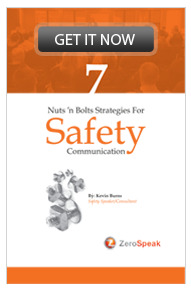Do not underestimate the power of a well-crafted safety campaign for supporting your safety initiatives.
 Federal elections are in full-swing in Canada, USA, Argentina and Hong Kong. But then, there are elections always going on somewhere. But it’s the national elections that dominate the TV and radio airwaves. All of the political parties fight for attention of voters in the hopes of swaying their ballot “X.”
Federal elections are in full-swing in Canada, USA, Argentina and Hong Kong. But then, there are elections always going on somewhere. But it’s the national elections that dominate the TV and radio airwaves. All of the political parties fight for attention of voters in the hopes of swaying their ballot “X.”
The political parties constantly assess their messages’ effectiveness. If the message isn’t resonating with the voter, they change it up in the hopes that the new message does. They engage polls and surveys. They take random sample sizes and ask questions. And they buy advertising.
Advertising is a one-way street: outward. It talks at us not with us. There is no conversation. There is no engagement. However, to improve safety communication is not about buying advertising. To build engagement, especially in safety, requires more than just banners and signs, or a few words at the monthly safety meeting.
How Do You Determine Your Safety Message Effectiveness?
Let’s think about how you present your safety message - or whatever message gets passed around your worklplace in the void of not having a coherent safety message. Does the intended message resonate with your audience (employees)? Do they make the right decisions as a result? Are you checking in (polling) to see what parts of the safety messages are hitting home and which parts are missing the mark? Or are you simply putting up a Be Safe! banner and hoping that does it?
If that’s your messaging effort, your safety campaign will fail. Be Safe! is not a message anyone can get behind. Be Safe! is an incomplete set of instructions. Besides, you can’t convince anyone to “be” anything. It’s what you want them to “do” that matters.
Millions Spent On Marketing
Many companies will spend millions on outside marketing strategies to convert readers/viewers/web-visitors into buyers. They will build interactive web sites for outside clients, develop social media campaigns and hire social media staff to answer queries. They will open and staff call centres, engage traditional media advertising, become involved in charities and sponsorships and will be highly visible. That’s just in an effort to make their product or service recognizable. That's because marketing and communication works. So, what are you doing to raise the profile of safety in your workplace?
If you want to improve the success of your safety program, consider these top 3 strategies for safety communication:
1Get rid of one-way communication. Employers and safety managers need to grasp that employees are their inside customers. Like outside customers, saying something once isn’t enough. Sending a memo is like a single tweet on Twitter: some will see it, most won't. And of those who do see it, most will do nothing and just move onto the next message. However, there is a good chance your message will get noticed only if it provides some sort of value or you have developed a history of engaging people. Your safety meetings might be the first place you start. Most are one-way lectures of stats and reports and really don’t engage employees. So stop doing it that way. Blow-up your safety meetings format and find ways to have conversations instead.
2Tie your safety message to something other than safety. Courtesy Matters® is a program upon which Encana has built their safety program. Courtesy Matters® is a company-wide program focused on being a good neighbour in the areas where Encana operates. Being courteous means doing courteous acts. If you are able to offer courtesy to your outside neighbours, then it’s easy for courtesy to begin inside the company gates. You will not find a solid safety program that doesn’t have courtesy and respect at it’s very foundation. Besides, “safely” is the thing you do. “Safety” is the result. You don’t have to have the word “safety” in your safety message in order for people to understand it. In fact, it’s probably going to be better welcomed if the word “safety” isn’t in the message at all. You can still act safely without saying the word safety. Can you communicate in a few words what you want your people to do differently - and not use the word safety?
3Engage in building relationships. Employees will engage in safety in direct proportion to how well their managers and supervisors engage them. They will care about their own safety when they know how much you care about them. Are you building relationships with the whose safety you are tasked with overseeing? Do you know all of their names and the names of their families? Your employees MUST become your primary market for communication. Safety isn’t a thing you do at arm’s length. It’s more successful when you’re working it shoulder-to-shoulder. Get to know your people. You will find out that they are good people wanting to do the right thing but may just not understand what your message is asking them to do. But they will when you have a one-on-one conversation.
 Sometimes all it takes is a walk across the shop floor or jobsite to realize that your safety messaging is being ignored. Do not underestimate the power of a well-crafted safety campaign for supporting your safety initiatives. Safety is not only a program you offer in your workplace. It is the goodwill and care that you show your people. You must get good at crafting messages that resonate with employees if you want them to buy-in to safety.
Sometimes all it takes is a walk across the shop floor or jobsite to realize that your safety messaging is being ignored. Do not underestimate the power of a well-crafted safety campaign for supporting your safety initiatives. Safety is not only a program you offer in your workplace. It is the goodwill and care that you show your people. You must get good at crafting messages that resonate with employees if you want them to buy-in to safety.
Kevin Burns is a management consultant, safety speaker and author of "The Perfect Safety Meeting" and his newest #1 Amazon Health & Safety Bestseller, "Running With Scissors - 10 Reasons To Invest in Safety In Slow Times." He is an expert in how to get through to people - how to talk with them so they hear and understand. Kevin's presentation "Trust The Process - Instill A Safety Attitude To Build An Engaged Culture Of Safety" will help your organization reach the following goals: better engagement and buy-in to safety, increased teamwork, better communication, lower turnover resulting in increased profits from production. Click here for more information and to discuss your needs with Kevin.
(c) Can Stock Photo

